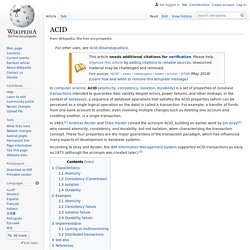

NoSQL. "Structured storage" redirects here.

For the Microsoft technology also known as structured storage, see COM Structured Storage. A NoSQL (often interpreted as Not Only SQL[1][2]) database provides a mechanism for storage and retrieval of data that is modeled in means other than the tabular relations used in relational databases. Motivations for this approach include simplicity of design, horizontal scaling and finer control over availability. The data structure (e.g. key-value, graph, or document) differs from the RDBMS, and therefore some operations are faster in NoSQL and some in RDBMS. There are differences though, and the particular suitability of a given NoSQL DB depends on the problem it must solve (e.g. does the solution use graph algorithms?). History[edit] There have been various approaches to classify NoSQL databases, each with different categories and subcategories.
A more detailed classification is the following, by Stephen Yen:[9] ACID. Set of properties (atomicity, consistency, isolation, durability) of database transactions intended to guarantee validity even in the event of errors, power failures, etc.

According to Gray and Reuter, IMS supported ACID transactions as early as 1973 (although the term ACID came later).[3] Characteristics[edit] The characteristics of these four properties as defined by Reuter and Härder are as follows: Atomicity[edit] An example of an atomic transaction is a monetary transfer from bank account A to account B. Consistency[edit] Isolation[edit] Durability[edit] Examples[edit] The following examples further illustrate the ACID properties. CREATE TABLE acidtest (A INTEGER, B INTEGER, CHECK (A + B = 100)); Atomicity[edit] Atomicity is the guarantee that series of database operations in an atomic transaction will either all occur (a successful operation), or none will occur (an unsuccessful operation). Consistency failure[edit]
CAP theorem. In theoretical computer science, the CAP theorem, also known as Brewer's theorem, states that it is impossible for a distributed computer system to simultaneously provide all three of the following guarantees:[1][2][3] In 2012 Brewer clarified some of his positions, including why the oft-used "two out of three" concept can be misleading or misapplied, and the different definition of consistency used in CAP relative to the one used in ACID.[4] History[edit] The proof of the CAP theorem by Gilbert and Lynch is a bit narrower than that which Brewer had in mind.

The theorem sets up a scenario in which a replicated service is presented with two conflicting requests arriving at distinct locations at a time when a link between them is failed. The obligation to provide availability despite partitioning failures leads the services to respond; at least one of these responses shall necessarily be inconsistent with what a service implementing a true one-copy replication semantic would have done. Synchronizing Clocks In a Cassandra Cluster, Pt. 1: The Problem. This article was originally written by Viliam Holub Cassandra is a highly-distributable NoSQL database with tunable consistency.

What makes it highly distributable makes it also, in part, vulnerable: the whole deployment must run on synchronized clocks. It’s quite surprising that, given how crucial this is, it is not covered sufficiently in literature. And, if it is, it simply refers to installation of a NTP daemon on each node which – if followed blindly – leads to really bad consequences. You will find blog posts by users who got burned by clock drifting. In the first installment of this two part series, I’ll cover how important clocks are and how bad clocks can be in virtualized systems (like Amazon EC2) today.
About clocks in Cassandra clusters Cassandra serializes write operations by time stamps you send with a query. Boot-time system clock synchronization is not enough unfortunately. How much clocks need to be synchronized? Network Time Protocol How to install NTP daemon 3.